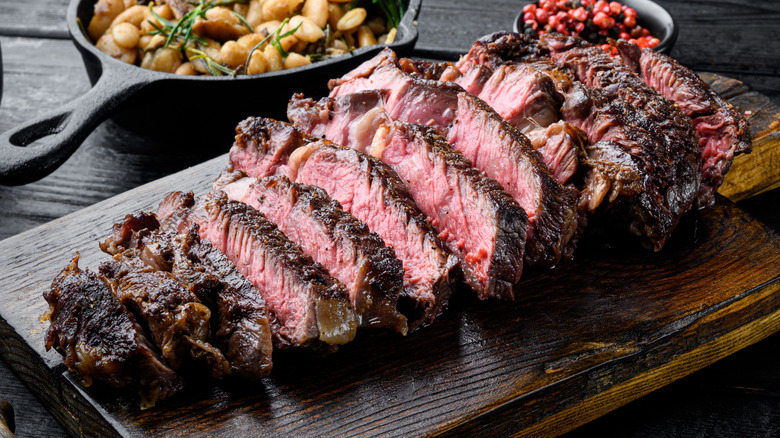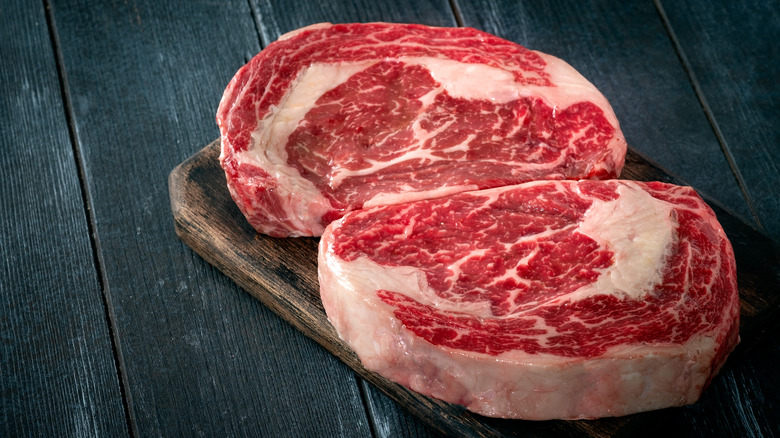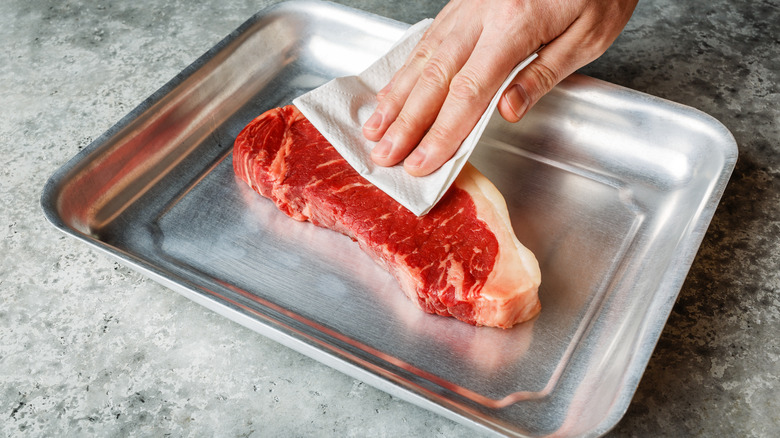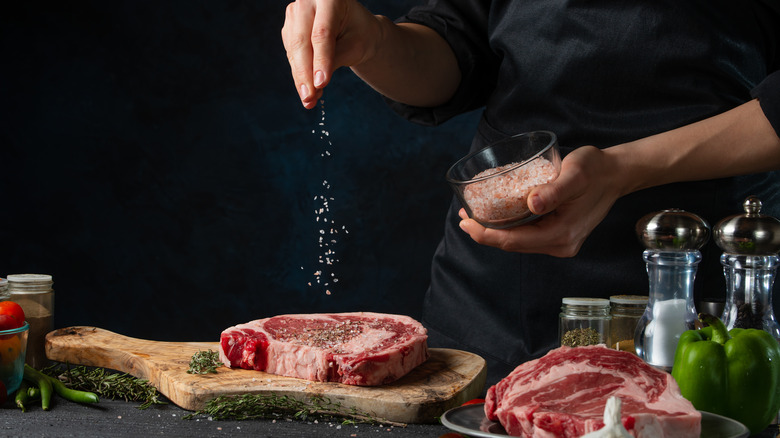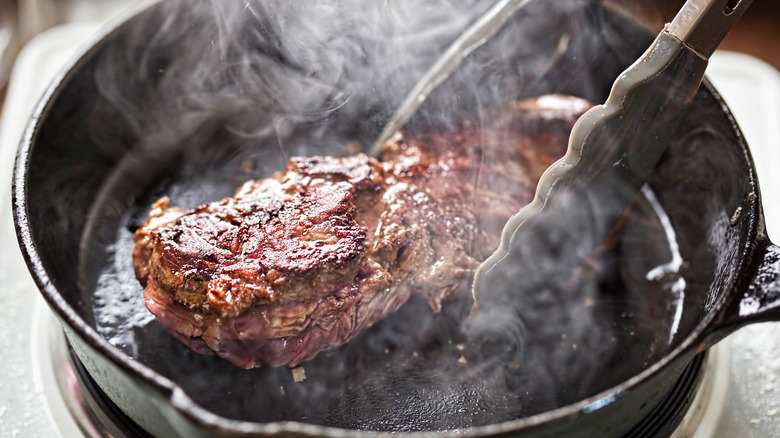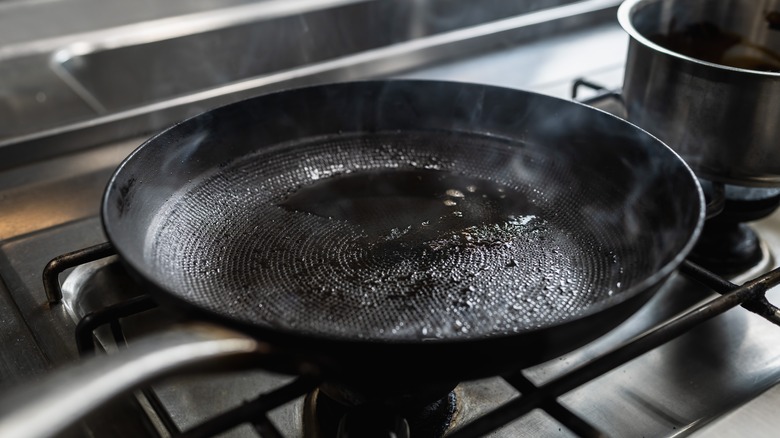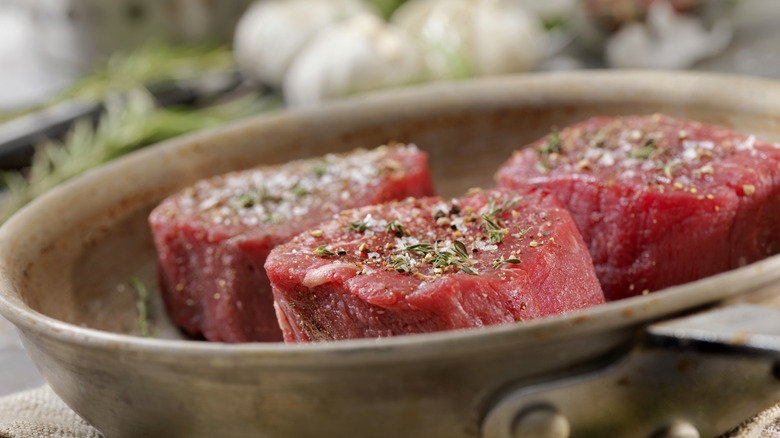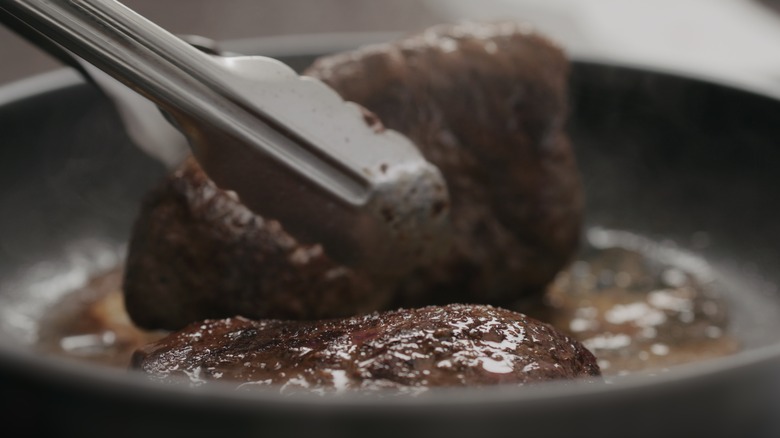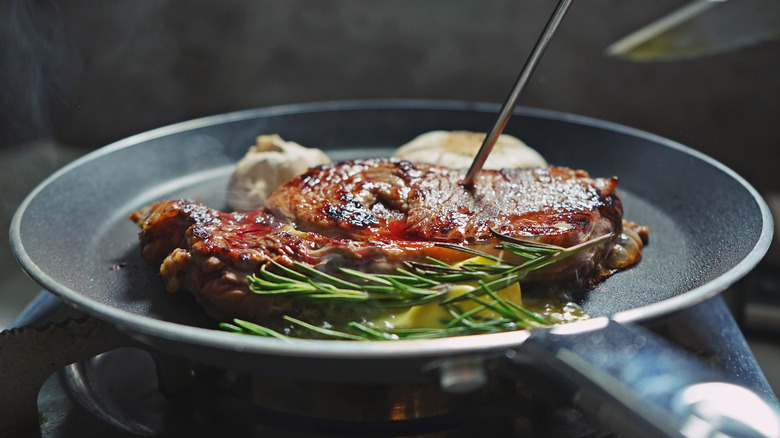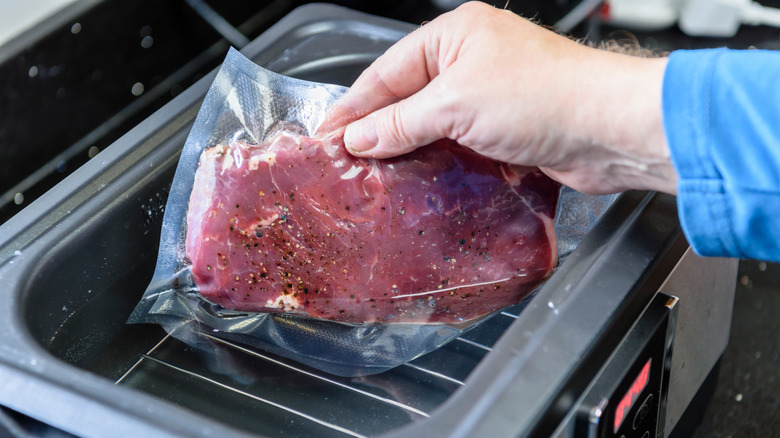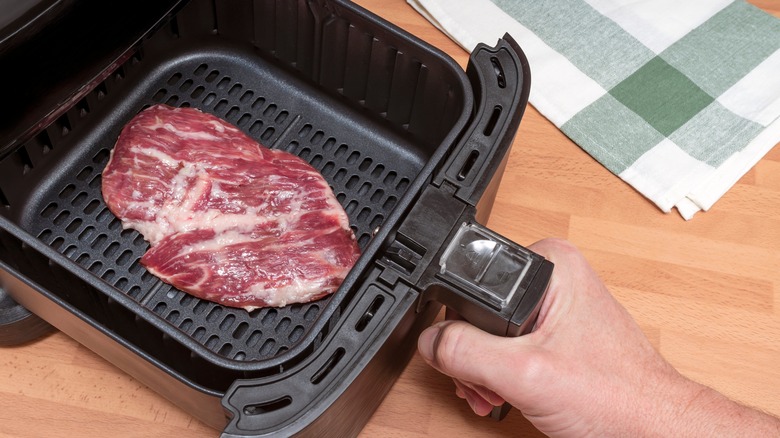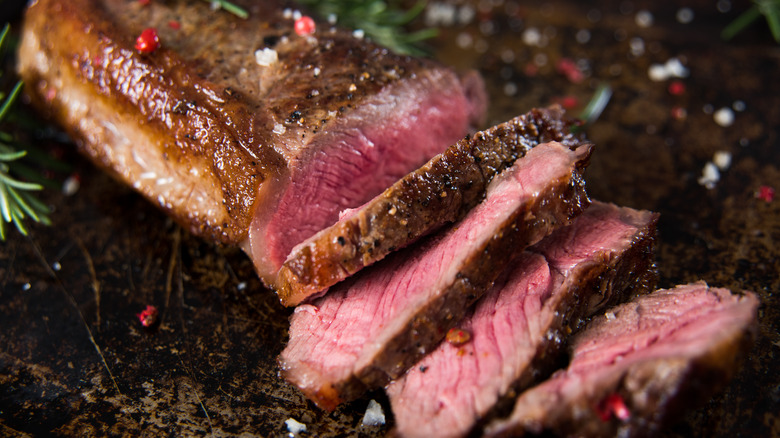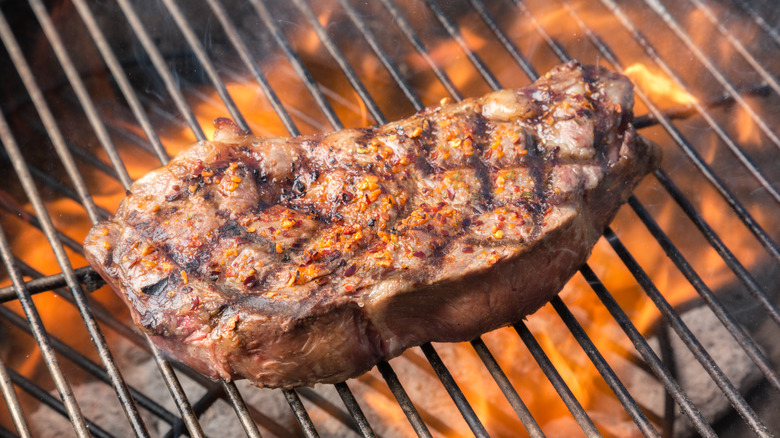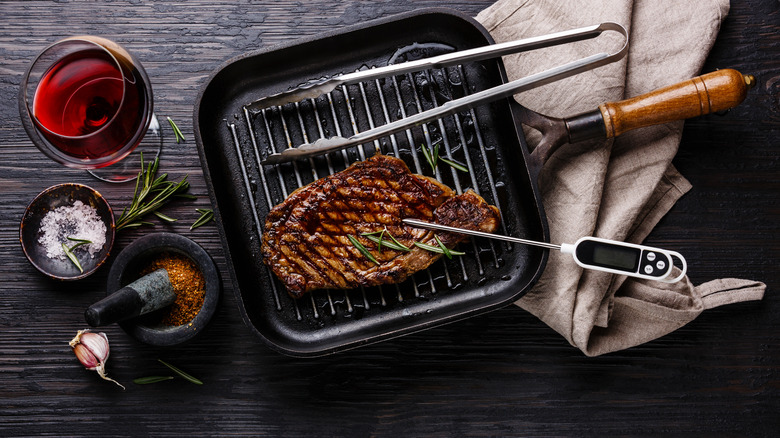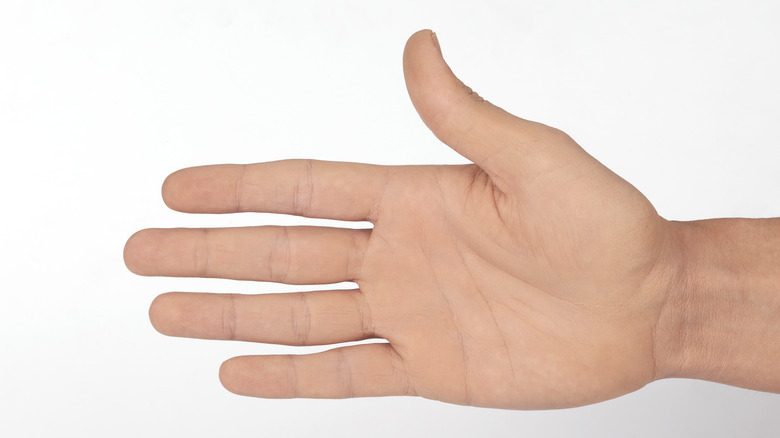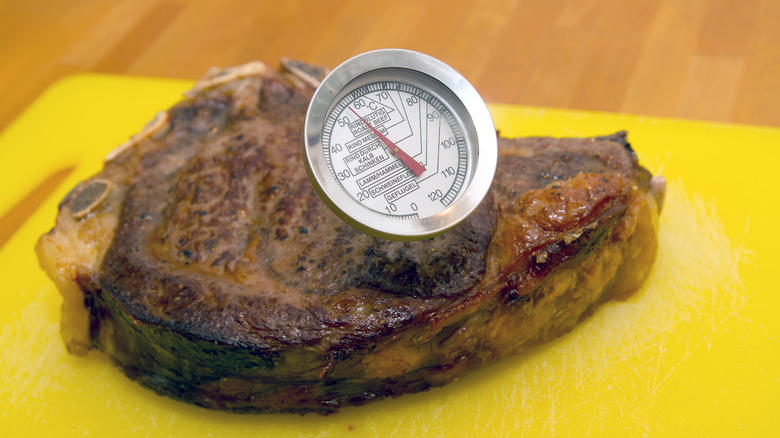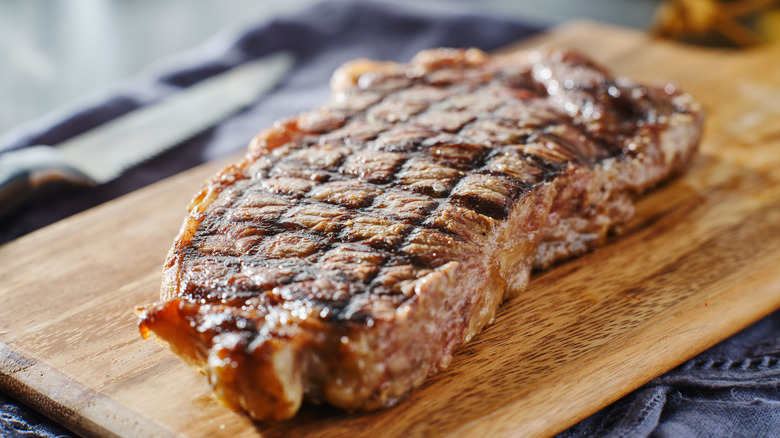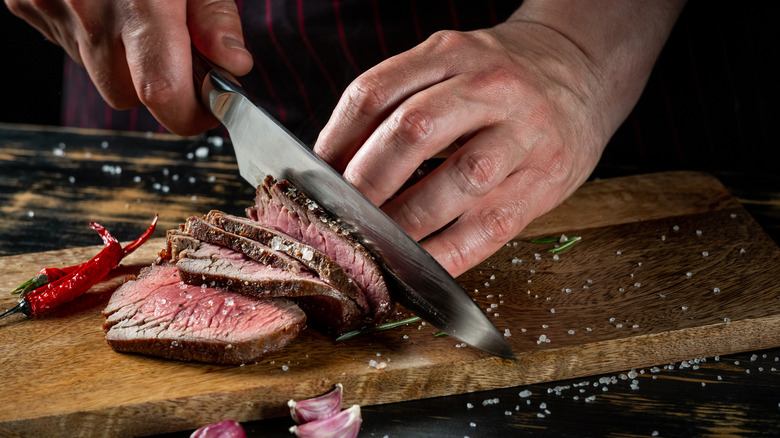19 Tips For Cooking A Perfect Medium-Rare Steak Every Time
One of the things I pride myself on most as a chef is being told by guests of my restaurant that my steaks are prepared perfectly. Getting a steak to a precise medium-rare every single time can seem like a magic trick only select unicorn chefs can achieve, but it is not. It is a skill set that anyone can master with the right tools and tricks of the trade.
The first key to becoming a steak specialist is understanding what medium-rare is. A medium-rare steak has a caramelized exterior and a juicy, hot, pink center that is no longer bloody. The primary reason to eat a medium-rare steak is that it enables the inherent flavor of the meat to shine, showcasing its minerality, what the cow was fed, and how it was cared for. It is the best way to appreciate eating meat without the experience turning into a sanguinary celebration or a masticating marathon.
Commit these chef-approved tips and tricks to memory if you want to catapult your steak skills into the stratosphere. The next time you entertain, your guests will sing your praises, and you will celebrate the satiating delight of eating the most epic steak of your life.
1. Select the right cut of steak
When looking for the ideal cut of steak to cook medium-rare, you will want to consider what part of the cow the cut comes from and how much marbling it has. Cuts from parts of the cow where the muscles were exercised the least, like the loin, will have more intramuscular fat, or marbling, than those from more utilized regions, like the hindquarters. This marbling is necessary to keep a steak moist and flavorful when using the high-heat cooking methods that typically yield a medium-rare steak.
When it comes to the thickness of a steak, you are better off with a thicker steak than a thin one. Steaks less than 1 inch thick tend to become overcooked far too quickly. Those over 2 inches thick can be challenging to get medium-rare doneness without incinerating the exterior. The ideal thickness for a perfectly medium-rare steak is between 1 ½ and 1 ¾ inches in diameter.
2. Bring the steak to room temperature
Regardless of which cooking method you use or which cut of steak you choose, bringing the meat to room temperature is crucial to obtain a perfectly cooked medium-rare result. The primary reason this is important is to guarantee that the steak cooks evenly.
A cold steak can sear on the outside while the internal temperature remains cold. Additionally, placing a cold steak into a hot pan will reduce the temperature of the surface of the cooking vessel, causing the meat to steam rather than sear.
For best results, it is recommended that you remove your steak from the refrigerator approximately 30 minutes before you intend to cook it. Additionally, take the steak out of its packaging and transfer it to a plate as you allow it to come to room temperature so it warms up evenly.
3. Pat the meat dry
Before cooking your steak, pat the meat dry on all sides using a paper towel. Removing residual moisture from the meat is necessary for two reasons. First, it helps to adhere the salt to your steak without dissolving. Second, it guarantees a good sear on your meat, a factor integral to obtaining maximum flavor.
When a moist steak hits a hot pan, it drops the temperature of the surface of the cooking vessel, causing the meat to steam rather than encouraging the onset of the Maillard reaction. This process during which meat obtains its characteristic browned crust occurs at 280 degrees Fahrenheit. Because water is such an effective conductor of heat, it will take quite a while for excess liquid to evaporate and the pan to return to the optimum temperature for searing your steak.
4. Use the right kind of salt
There has long been a debate among chefs regarding whether or not to salt your steak before cooking it and, if so, what kind of salt to use. My professional opinion is that the only way to ensure a steak is adequately seasoned is to salt it before you cook it. The key is timing. It would help if you either seasoned it immediately before adding it to the pan, after patting it dry, or more than an hour before doing so, encouraging any excess moisture within the meat to be fully pulled to the surface of the steak by the salt.
When seasoning, do so liberally using a coarse kosher or sea salt grain. I recommend transferring the salt to a bowl and using your fingers to sprinkle the salt over your steak from a few inches above the meat to spread it evenly across the surface of the meat.
5. Use the right kind of pan
While I have long maintained that you do not need to invest in the most expensive pans to achieve stellar results in the kitchen, you do need a decent quality pan that can withstand high-heat cooking to encourage the Maillard reaction to occur and obtain the proper sear required for the perfect medium-rare steak. The best quality material for this purpose is cast iron, stainless steel, or carbon steel.
The worst type of pan to use is a non-stick one. While they are designed for consistent cooking without excess fat, they are not ideal for high-heat preparations. Regardless of the pan you use, ensure it is oven-safe from the surface of the cooking vessel to the handle. This will enable you to use cooking methods designed to go from stove top to oven without transferring the meat to another cooking vessel to finish it.
6. Start with a hot pan or grill
As we have noted from the selection of the cut of your steak to what kind of pan to use, high heat is a primary consideration when cooking the perfect medium-rare steak. Whether you cook your steak stove top or grill it, doing so at a temperature that will quickly get your meat to the magical temperature of 280 degrees Fahrenheit as rapidly as possible is crucial. This will encourage the commencement of the Maillard reaction and form the perfect sear, which will produce the best-tasting, juiciest steak.
With that in mind, you must decide what fat to use to cook your steak. Though you can use butter or oil, butter tends to burn rapidly, while olive oil is not intended for high-heat cooking. A combination of butter and a high smoke point oil, like grapeseed or sunflower, is optimal.
7. Don't overcrowd the pan
A common mistake novice chefs make when cooking steak is preparing too many at once. While it may seem like a great idea to get all your steaks done simultaneously, this will backfire in the long run.
Putting too many steaks into the pan at once will lower its temperature. As we know, when the temperature gets lowered, the steaks will steam rather than sear, thereby inhibiting the onset of the Maillard reaction and yielding flavorless, colorless meat.
If you are feeding a crowd and need to prepare multiple steaks but don't have a big enough pan to prepare them without squishing them in too tightly, you will want to cook them in batches. You can keep the steaks warm by placing them onto a baking sheet or plate and covering them with aluminum foil.
8. Flip your steak frequently for even cooking
Some chefs may suggest placing your steak into a hot pan and flipping it only once for the perfect sear. While there are reasons this advice may be recommended, including concerns over lowering the temperature of the pan every time you flip your steak, research has shown that flipping it more frequently can make for a quicker and better quality result.
As long as you have thoroughly dried your steak, continuous flipping can promote dehydration of any residual moisture that may form on the surface of the meat, resulting in more evenly cooked meat. Flipping can also help reduce overall cooking time by up to 30%. Though some steakhouses recommend flipping your meat every 30 seconds, you do not have to be quite as meticulous in your kitchen. Just use your intuition and flip it periodically until your steak is golden brown on both sides.
9. Finish your steak in the oven
My go-to method for cooking the perfect medium-rare steak is to start it in the pan and finish it in the oven. This is particularly useful when cooking a thicker cut of meat. It ensures that the Maillard reaction has commenced by searing the meat's exterior while enabling the center to reach the appropriate temperature for a medium-rare steak, between 130 and 135 degrees Fahrenheit.
Preheat the oven to 375 degrees Fahrenheit before you begin cooking your steak. Once the oven is at the correct temperature, get your dried, seasoned, room-temperature steak into the butter and oil mixture in your hot pan and sear well on both sides. Transfer the pan with the steak into the oven and allow to finish, which should take another 5 to 10 minutes, depending on the size of your steak and your oven.
10. Pan Sear the steak
Pan-sear steaks from beginning to end for an easy cooking method that relies heavily on aromatics for flavoring. This method is effective with thick and thin cuts of meat but can be the best way to guarantee you do not overcook those thinner steaks. It relies on infusing your steaks with seasonings toward the end of the cooking process while they finish cooking.
Start your steaks in a hot pan over high heat. Once you have seared your steaks on both sides, continue cooking until they have reached about 120 degrees Fahrenheit. Toward the last minute or two of cooking, add a pat of butter, fresh herbs, like rosemary or a sprig of thyme, minced garlic, and finely chopped shallots. As the butter melts, gently spoon it over the steaks, basting them to impart them with the aromatics and keep them moist.
11. Sous vide the steak
Sous vide translates to "under vacuum." It is a cooking method that takes food packaged in a vacuum-sealed, heat-safe bag and cooks it in a water bath using a carefully regulated piece of equipment now available to home cooks everywhere. The advantage of this low, slow, precise culinary technique, particularly where cooking a medium-rare steak is concerned, is that it will evenly cook your meat throughout without the muscle fibers contracting and squeezing out those much-needed juices.
Once the meat has reached the correct temperature, it is rapidly pan-seared to obtain that quintessential browned crust before being served. The result is a moist, flavorful, and uniformly medium-rare steak from end to end. The cost of the equipment, the lack of a robust crust, and a final product that can seem cold compared to steaks cooked on the stovetop or in an oven are the only downsides to this method.
12. Air fry the steak
Air fryer recipes are all the rage right now. After all, air frying is a quick and simple way to cook virtually anything, including the perfectly prepared medium-rare steak, without extra fuss or clean-up, but this requires a bit of finesse. The superpower of an air fryer is that it allows heat to circulate evenly around your meat, cooking the exterior and creating a browned crust while trapping those juices inside.
The key is not overcooking your steak. For this reason, thicker cuts work best in the air fryer. Prepare your steak as you would for any other cooking method. Once you set your air fryer to 400 degrees Fahrenheit, you will want to place your lightly oiled and seasoned meat into the unit. A 1 ½ inch thick steak should be ready in about 10 minutes, flipping once halfway through, but you may need to adjust timing based on your unit.
13. Reverse sear the steak
The reverse sear method is one of the best techniques for cooking a medium-rare steak to obtain the uniformity you get from the sous vide method while also conferring the characteristic robust crust created by pan-searing. This technique is intended for a thick-cut steak between 1 ½ and 2 inches, not a thin one.
Once you have seasoned your steak, place it onto a baking sheet lined with a wire rack. Roast it low and slow in an oven preheated to 250 degrees Fahrenheit until the meat reaches 115 degrees Fahrenheit. Finish the steak by pan-searing it in a hot pan lined with oil for approximately a minute per side. The only disadvantage to cooking steak this way is that it takes slightly longer than other methods. That said, the consistency of this method may be worth the added time.
14. Grill the steak
Regardless of the efficacy of many other methods for cooking a steak to a perfect medium-rare every time, nothing can replace the multi-sensory experience of grilling meat. From the grill marks to the aromas of the meat to the distinct complex smoky taste and texture conferred by charcoal or wood, this culinary method will always reign supreme for some.
The exquisite high heat of a grill is ideal for encouraging the Maillard reaction, which is the key to a great steak. Remember to oil your steak before grilling it rather than trying to oil the grill, which can cause a flare-up. And you will want to maintain the grill at a temperature between 450 and 500 degrees Fahrenheit. Lastly, remember to flip your meat frequently to encourage more even cooking. For best results, make sure you clean your grill between uses.
15. Use a thermometer
Though virtually every recipe and method for cooking steak indicates an approximate cooking time to obtain the ideal medium-rare doneness for a particular thickness of a cut, every stovetop, oven, grill, piece of meat, and the chef is unique, making absolutes impossible when it comes to figuring out whether or not your steak is cooked. The only foolproof method to ensure your steak is at a precise medium-rare temperature is to use a thermometer.
The best kind of thermometer for testing the temperature of a steak is a digital one that does not need to be regularly calibrated for accuracy. To register the temperature of your steak, insert your thermometer into the side of your meat at the thickest section of the cut. One downside to using a thermometer? The steak will leak juices from the puncture hole where the thermometer was placed.
16. Use the touch technique
The "touch" technique for steak is a method that is less accurate but is both convenient and ensures that you do not lose any of those valuable juices that keep your steak moist on the inside by piercing the steak with a thermometer. However, it requires some experience and finesse to master. The basic technique involves comparing the doneness of meat to the fleshy part of your palm just below your thumb.
When you hold your hand open, this fleshy area is squishy, equivalent to a rare steak. If you touch your index finger to your thumb, you will notice this region becomes slightly firmer. This resembles the doneness of a medium-rare steak. If you touch the steak with your hand and it feels like your palm does when your index finger and thumb are joined, your meat is medium-rare. Test multiple areas of your steak to assess overall doneness, and wash your hands thoroughly before touching the meat.
17. Factor in carryover cooking time
We have already assessed that the ideal temperature for a medium-rare steak is between 130 and 135 degrees Fahrenheit. Understanding this is crucial, but what is even more critical is factoring in what is known as carryover cooking time when you remove a steak from the pan, grill, or oven.
Carryover cooking time occurs when a steak continues cooking after removing it from its heat source. This process can last up to 20 minutes post cooking depending upon the heat source and thickness of the cut of meat.
Thicker cuts will have a longer carryover cooking time, as will meats cooked via higher heating methods. What this means for your steak is that you should remove it from your heat source when it is approximately 5 degrees Fahrenheit below your ideal endpoint. For a medium-rare steak, this would be at around 125 degrees Fahrenheit.
18. Let the steak rest
The most crucial step in ensuring a delicious steak-eating experience is allowing it to rest before cutting into it. As it cooks, moisture is repelled from the crust of the steak and drawn into the muscle fibers at the center of the meat. If you were to cut into a steak immediately after removing it from its heat source, all of these concentrated juices would squirt out of the meat and be lost on your plate.
As a steak is allowed to rest, the outside perimeter of the meat begins to cool, allowing those concentrated juices to make their way back to the surface of the cut. After roughly 10 minutes, all of those juices will have been redistributed, ensuring your entire steak is moist, not just the center of it. For best results, it is best to rest meat without covering it. Thicker cuts of meat may take longer to rest than thin ones.
19. Slice the steak against the grain
You have selected, prepared, cooked, and rested your steak. Now is the moment when you serve this perfectly medium-rare steak. Believe it or not, one final step can derail all of your precision and attention to detail – how you slice your meat. Every steak has muscle fibers that are visible in the meat. They look like parallel lines layered end to end along the steak. This is called the grain.
To get the most tender cut of meat, you should always cut against this grain or perpendicular to it. Doing so will cut these muscle fibers into shorter segments, which are easier to chew. Failure to do so can leave you gnawing at even a tender steak in perpetuity. Grab your sharpened chef's knife and make vertical incisions straight through these muscle fibers for the best bite of medium-rare steak you have ever eaten.
